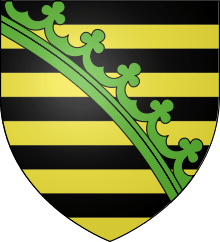Saxe-Zeitz
| Duchy of Saxe-Zeitz | ||||||||||
| Herzogtum Sachsen-Zeitz | ||||||||||
| Secundogeniture | ||||||||||
| ||||||||||
| Capital | Zeitz | |||||||||
| Government | Duchy | |||||||||
| Historical era | Early modern Europe | |||||||||
| • | Split off from Electorate of Saxony | 1657 | ||||||||
| • | Fell back to the Electorate of Saxony | 1718 | ||||||||
| ||||||||||
The Duchy of Saxe-Zeitz was a territory of the Holy Roman Empire of German Nation from 1656/57 to 1718. Its capital was Zeitz. It was owned by the Albertine branch of the House of Wettin.
History
The Saxon Elector John George I stipulated in his will dated 20 July 1652 that his three younger sons should receive secundogeniture principalities. After the elector died on 8 October 1656, his sons concluded the "friend-brotherly main treaty" in Dresden on 22 April 1657 and a further treaty in 1663 delineating their territories and sovereign rights definitely. The treaties created three duchies:
- Saxe-Zeitz,
- Saxe-Weissenfels and
- Saxe-Merseburg.

Prince Maurice, the fourth-oldest son received the castles, cities and district which had belonged to the Diocese of Naumburg, which had been secularized in 1562. He also received the city of Schleusingen in 1660, which had until then been the residence of the County of Henneberg. Maurice resided in the City Castle of Naumburg until his Moritzburg Palace in Zeitz had been completed.
Rulers
The only rulers were Duke Maurice of Saxe-Zeitz and his son Duke Moritz Wilhelm of Saxe-Zeitz.
This line was the first of the three secundogenitures to die out. It died out in 1718 when the only male heir, Prince Christian August, joined the clergy.
Relatives
- Dorothea Wilhelmine of Saxe-Zeitz (1691-1743), Princess of Saxe-Zeitz by birth and by marriage Landgravine of Hesse-Kassel

